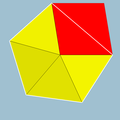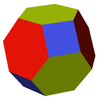- Snub cube
-
Snub cube 
(Click here for rotating model)Type Archimedean solid
Uniform polyhedronElements F = 38, E = 60, V = 24 (χ = 2) Faces by sides (8+24){3}+6{4} Schläfli symbol s{4,3} Wythoff symbol | 2 3 4 Coxeter-Dynkin 




Symmetry O, [4,3]+, (432) Dihedral Angle References U12, C24, W17 Properties Semiregular convex chiral 
Colored faces
3.3.3.3.4
(Vertex figure)
Pentagonal icositetrahedron
(dual polyhedron)
NetIn geometry, the snub cube, or snub cuboctahedron, is an Archimedean solid.
The snub cube has 38 faces, 6 of which are squares and the other 32 are equilateral triangles. It has 60 edges and 24 vertices. It is a chiral polyhedron, that is, it has two distinct forms, which are mirror images (or "enantiomorphs") of each other. The only other chiral Archimedean solid is the snub dodecahedron.
Contents
Dimensions
For a snub cube with edge length 1, its surface area is
 and its volume is
and its volume is  , where t is the tribonacci constant
, where t is the tribonacci constant ![\frac{1}{3}(1+\sqrt[3]{19-3\sqrt{33}}+\sqrt[3]{19+3\sqrt{33}}) \approx 1.83929](2/d624dbe767f585b5a8d2999bc11e71dc.png) .
.If the original snub cube has edge length 1, its dual pentagonal icositetrahedron has side lengths
 and
and  .
.Cartesian coordinates
Cartesian coordinates for the vertices of a snub cube are all the even permutations of
- (±1, ±ξ, ±1/ξ)
with an even number of plus signs, along with all the odd permutations with an odd number of plus signs, where ξ is the real solution to
- ξ3+ξ2+ξ=1,
which can be written
or approximately 0.543689. ξ is the reciprocal of the tribonacci constant. Taking the even permutations with an odd number of plus signs, and the odd permutations with an even number of plus signs, gives a different snub cube, the mirror image.
This snub cube has edges of length α, a number which satisfies the equation
- α6−4α4+16α2−32=0,
and can be written as
For a snub cube with unit edge length, use the following coordinates instead:



 --This formula is wrong, but the value correct.[improper synthesis?]
--This formula is wrong, but the value correct.[improper synthesis?]![c_1=\sqrt[3]{3\sqrt{33}+17}](7/df7c9288d7d95c55210e6005d75fc5ba.png)
![c_2=\sqrt[3]{3\sqrt{33}-17}](4/e646e0ff817210468af7168f62d6f6e9.png)
![c_3=\sqrt[3]{199+3\sqrt{33}}](f/5bfca8da4e858e2339835f94c6913af4.png)
![c_4=\sqrt[3]{199-3\sqrt{33}}](e/c0e2df6775c3ad437ba098afbd5db6ca.png)
Geometric relations
The snub cube can be generated by taking the six faces of the cube, pulling them outward so they no longer touch, then giving them each a small rotation on their centers (all clockwise or all counter-clockwise) until the spaces between can be filled with equilateral triangles.

Cube
Rhombicuboctahedron
(Expanded cube)It can also be constructed as an alternation of a nonuniform omnitruncated cube, deleting every other vertex and creating new triangles at the deleted vertices. A properly proportioned (nonuniform) great rhombicuboctahedron will create equilateral triangles at the deleted vertices. Depending on which set of vertices are alternated, the resulting snub cube can have a clockwise or counterclockwise twist.
A "improved" snub cube, with a slightly smaller square face and slightly larger triangular faces compared to Archimedes' uniform snub cube, is useful as a spherical design.[1]
Related polyhedra and tilings
This semiregular polyhedron is part of sequence of snubbed polyhedra and tilings with vertex figure (3.3.3.3.p) and Coxeter-Dynkin diagram




 , which can be constructed as alternations of the omnitruncation sequence
, which can be constructed as alternations of the omnitruncation sequence 



 .
.232 332 432 532 632 732 832 
(4.6.4)






(4.6.6)






(4.6.8)






(4.6.10)






4.6.12






4.6.14






4.6.16






(3.3.3.3.2)






(3.3.3.3.3)






(3.3.3.3.4)






(3.3.3.3.5)






3.3.3.3.6






3.3.3.3.7






3.3.3.3.8





See also
References
- ^ "Spherical Designs" by R. H. Hardin and N. J. A. Sloane
- Jayatilake, Udaya (March 2005). "Calculations on face and vertex regular polyhedra". Mathematical Gazette 89 (514): 76–81.
- Williams, Robert (1979). The Geometrical Foundation of Natural Structure: A Source Book of Design. Dover Publications, Inc. ISBN 0-486-23729-X. (Section 3-9)
External links
- Eric W. Weisstein, Snub cube (Archimedean solid) at MathWorld.
- Richard Klitzing, 3D convex uniform polyhedra, s3s4s - snic
- The Uniform Polyhedra
- Virtual Reality Polyhedra The Encyclopedia of Polyhedra
- Editable printable net of a Snub Cube with interactive 3D view
Polyhedron navigator Platonic solids (regular) Archimedean solids
(Semiregular/Uniform)Catalan solids
(Dual semiregular)triakis tetrahedron · rhombic dodecahedron · triakis octahedron · tetrakis cube · deltoidal icositetrahedron · disdyakis dodecahedron · pentagonal icositetrahedron · rhombic triacontahedron · triakis icosahedron · pentakis dodecahedron · deltoidal hexecontahedron · disdyakis triacontahedron · pentagonal hexecontahedronDihedral regular Dihedral uniform Duals of dihedral uniform Dihedral others Degenerate polyhedra are in italics.Categories:- Chiral polyhedra
- Uniform polyhedra
- Archimedean solids
Wikimedia Foundation. 2010.

![\xi = \frac{1}{3}\left(\sqrt[3]{17+3\sqrt{33}} - \sqrt[3]{-17+3\sqrt{33}} - 1\right)](a/4da02cf1ceb888f7426e29789a516e01.png)
![\alpha = \sqrt{\frac{4}{3}-\frac{32}{6\sqrt[3]{2}\beta}+\frac{6\sqrt[3]{2}\beta}{9}}\approx1.60972](5/1252846b576b869bcc5e5cc8067fa903.png)
![\beta = \sqrt[3]{13+3\sqrt{33}}](0/5d09b5e5fe22bfab0f8467326ed28394.png)













